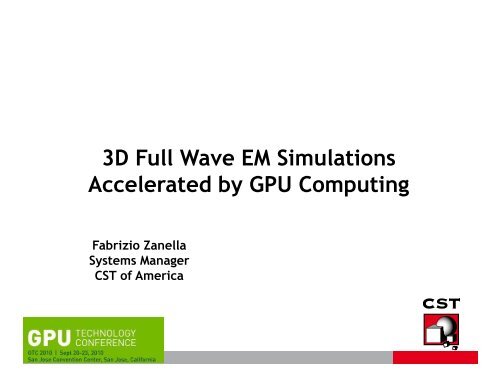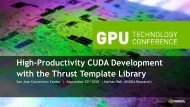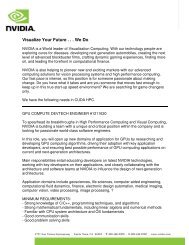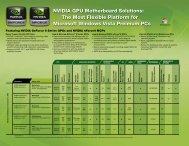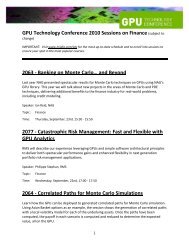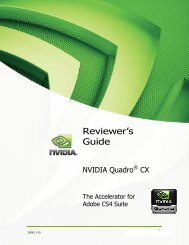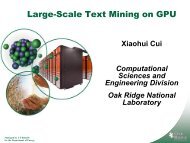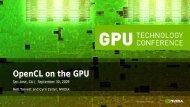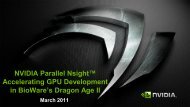Accelerated by GPU Computing - NVIDIA
Accelerated by GPU Computing - NVIDIA
Accelerated by GPU Computing - NVIDIA
Create successful ePaper yourself
Turn your PDF publications into a flip-book with our unique Google optimized e-Paper software.
www.cst.com 1<br />
3D Full Wave EM Simulations<br />
<strong>Accelerated</strong> <strong>by</strong> <strong>GPU</strong> <strong>Computing</strong><br />
Fabrizio Zanella<br />
Systems Manager<br />
CST of America
Abstract<br />
3D Full Wave Electromagnetic simulations of RF<br />
components, antennas, printed circuit boards, can be quite time<br />
consuming.<br />
The CST2010 tool suite includes the capability to activate <strong>GPU</strong><br />
<strong>Computing</strong>. Examples will be shown of using the Nvidia Tesla<br />
C1060, M1060 and S1070 configurations to provide significant<br />
performance improvements for complex simulations.<br />
www.cst.com 2
CST 3D Full Wave Complex Simulations<br />
www.cst.com 3
www.cst.com 4<br />
CST Hardware Based Acceleration<br />
Techniques Improve Performance<br />
Multithreading<br />
<strong>GPU</strong> <strong>Computing</strong><br />
Distributed <strong>Computing</strong> MPI <strong>Computing</strong>
CST <strong>GPU</strong> <strong>Computing</strong> Hardware<br />
CST MWS Transient Solver<br />
Available for OS: Licensing: Token Scheme<br />
Nvidia <strong>GPU</strong> hardware supported <strong>by</strong> CST21010; <strong>NVIDIA</strong> Tesla 10 series<br />
Quadro FX 5800/Tesla C1060 (1 <strong>GPU</strong>) Quadro Plex 2200 D2 (2 <strong>GPU</strong>s) Tesla S1070 (4 <strong>GPU</strong>s)<br />
• 240 Cores per <strong>GPU</strong><br />
• 4 GB GDDR3 memory per <strong>GPU</strong><br />
• Memory Bandwidth 102 GB/s (normal DDR3 RAM: 25.6 GB/s)<br />
As the Transient Solver performance is heavily influenced <strong>by</strong> the memory<br />
bandwidth it benefits a lot from the high bandwidth to the <strong>GPU</strong> memory.<br />
www.cst.com 5
Windows XP x64<br />
Windows Vista x64<br />
Windows 7 x64<br />
Windows Server 2003 R2<br />
Windows Server 2008 R2<br />
RHEL 4, 5<br />
CentOS 4,5<br />
www.cst.com 6<br />
Supported Configurations<br />
Workstations: HPZ800, Dell T7500, etc<br />
Servers: 1U, 2U SuperMicro GP-<strong>GPU</strong> servers
<strong>GPU</strong> <strong>Computing</strong> Hardware – CST2011<br />
<strong>NVIDIA</strong> Tesla 20 series, or Fermi supported in CST2011<br />
Tesla C2050<br />
Tesla C2070<br />
1 <strong>GPU</strong><br />
Tesla S2050<br />
Tesla S2070<br />
• 512 Cores per <strong>GPU</strong><br />
• 3 GB GDDR5 (C2050), 6 GB GDDR5 (C2070) memory per <strong>GPU</strong><br />
• First <strong>GPU</strong> with Error Protecting Code (ECC)<br />
• Floating Point Performance strongly improved <strong>by</strong> factor of about 8<br />
• C2050, C2070 supported in CST2011 release, Jan 2011<br />
www.cst.com 7<br />
4 <strong>GPU</strong>
Hardware Configurations used for<br />
benchmarks<br />
2U SuperMicro, Windows Server 2008 R2<br />
(8) E5530, 72GB DDR3 RAM<br />
Connected to <strong>NVIDIA</strong> Tesla S1070 (4xM1060)<br />
1U SuperMicro server, CentOS v5.5<br />
X8DAH+-F motherboard, 2xM1060 <strong>GPU</strong> cards<br />
(8) E5630, 48GB DDR3 RAM<br />
DC+<strong>GPU</strong> <strong>Computing</strong> used<br />
www.cst.com 8
<strong>GPU</strong> Benchmark: Disk Drive Interconnect<br />
www.cst.com 9<br />
Model = 25 M HEX cells; lossy metal and dielectrics<br />
<strong>GPU</strong>=2xM1060<br />
10X speedup over 8 Xeon X5550 cores
www.cst.com 10<br />
<strong>GPU</strong> Benchmark: Multilayer Package<br />
Model<br />
8xE5630 cores, 4 ports total time: 5.9 hours<br />
1xM1060 4 ports total time:1 hour<br />
5.9x performance improvement
www.cst.com 11<br />
<strong>GPU</strong> Benchmark: PCB Model<br />
8xE5630 cores; 4 ports total time: 23h,15m<br />
1xM1060; 4 ports total time: 3h,45m<br />
6.2x performance improvement
www.cst.com 12<br />
<strong>GPU</strong> Benchmark: PCB-Cable-PCB<br />
8xE5630 cores total time: 17 hours<br />
1xM1060 total time: 2 hours<br />
8.5x performance improvement
www.cst.com 13<br />
<strong>GPU</strong> Benchmark: Package on PCB<br />
Test Case # Nodes<br />
100M Mesh Cells<br />
CPU: 2x Intel Xeon E5530, 72 GB RAM<br />
<strong>GPU</strong>: <strong>NVIDIA</strong> Tesla S1070 (4xC1060)<br />
# Cores per<br />
Node<br />
# <strong>GPU</strong>s per<br />
Node<br />
Speedup<br />
Pure CPU 1 2x4 0 1<br />
<strong>GPU</strong> 1 2x4 4 16x
CST MPI Cluster <strong>Computing</strong><br />
Matrix calculation and transient solution distributed<br />
Memory & CPU balancing<br />
Complex model split into sub-structures (domains) for solution on a cluster<br />
www.cst.com 14
MPI <strong>Computing</strong> + <strong>GPU</strong> <strong>Computing</strong><br />
As the capacity of the <strong>GPU</strong> hardware is limited. Combined MPI and <strong>GPU</strong><br />
<strong>Computing</strong> provides a possibility to combine <strong>GPU</strong> accelerated nodes to<br />
form an MPI cluster. This helps to increase the maximum model size.<br />
Each MPI node can<br />
be accelerated <strong>by</strong><br />
<strong>GPU</strong> hardware.<br />
www.cst.com 15
MPI+<strong>GPU</strong> <strong>Computing</strong> Performance<br />
PCB and Package- 100M cells<br />
25<br />
20<br />
15<br />
10<br />
www.cst.com 16<br />
5<br />
0<br />
# Cores per # <strong>GPU</strong>s per Total #<br />
Test Case # Nodes Node Node <strong>GPU</strong>s<br />
Pure CPU 1 2x4 0 0<br />
MPI 8 2x4 0 0<br />
<strong>GPU</strong> 1 2x4 4 4<br />
MPI+<strong>GPU</strong> 4 2x4 2 8<br />
Speedup<br />
Pure CPU MPI <strong>GPU</strong> MPI+<strong>GPU</strong>
CST <strong>GPU</strong> <strong>Computing</strong><br />
- Conclusion -<br />
� CST <strong>GPU</strong> <strong>Computing</strong> provides a significan performance<br />
improvement for complex simulations.<br />
� The maximum model size (number of mesh cells) which can be<br />
handled <strong>by</strong> <strong>GPU</strong> <strong>Computing</strong> is limited <strong>by</strong> the amount of memory<br />
available on the <strong>GPU</strong> hardware (currently max. 4 GB).<br />
� For larger models multiple <strong>GPU</strong> cards can be used or combined MPI<br />
and <strong>GPU</strong> <strong>Computing</strong><br />
www.cst.com 17


